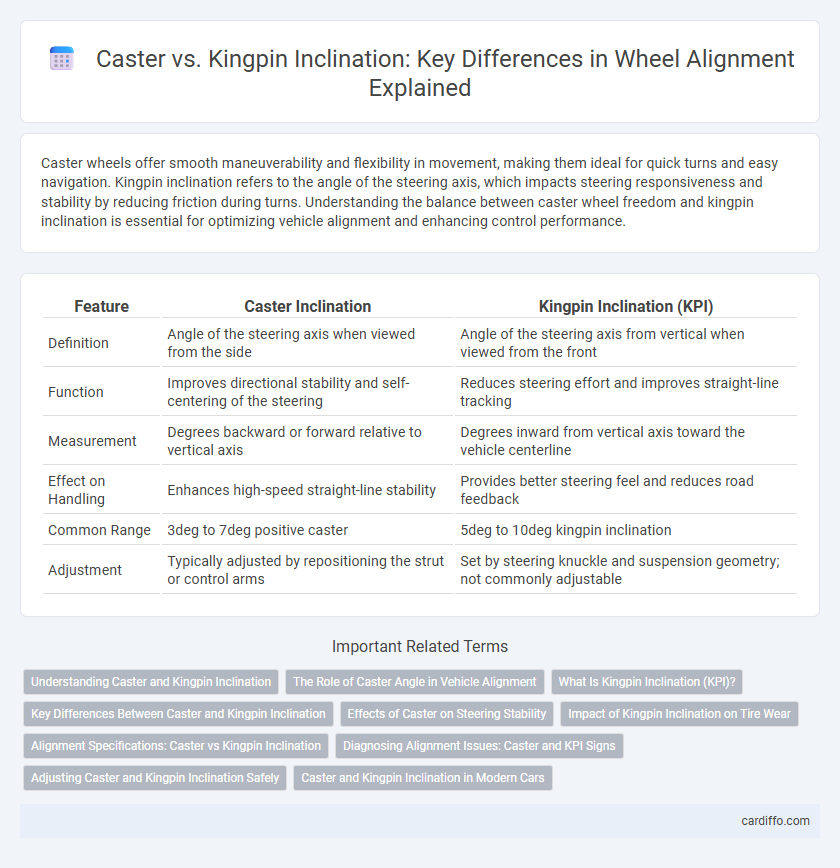Caster wheels offer smooth maneuverability and flexibility in movement, making them ideal for quick turns and easy navigation. Kingpin inclination refers to the angle of the steering axis, which impacts steering responsiveness and stability by reducing friction during turns. Understanding the balance between caster wheel freedom and kingpin inclination is essential for optimizing vehicle alignment and enhancing control performance.
Table of Comparison
| Feature | Caster Inclination | Kingpin Inclination (KPI) |
|---|---|---|
| Definition | Angle of the steering axis when viewed from the side | Angle of the steering axis from vertical when viewed from the front |
| Function | Improves directional stability and self-centering of the steering | Reduces steering effort and improves straight-line tracking |
| Measurement | Degrees backward or forward relative to vertical axis | Degrees inward from vertical axis toward the vehicle centerline |
| Effect on Handling | Enhances high-speed straight-line stability | Provides better steering feel and reduces road feedback |
| Common Range | 3deg to 7deg positive caster | 5deg to 10deg kingpin inclination |
| Adjustment | Typically adjusted by repositioning the strut or control arms | Set by steering knuckle and suspension geometry; not commonly adjustable |
Understanding Caster and Kingpin Inclination
Caster and kingpin inclination are critical angles in vehicle suspension geometry that influence steering stability and handling. Caster refers to the tilt of the steering axis viewed from the side, enhancing straight-line stability and self-centering of the steering wheel. Kingpin inclination is the inward tilt of the steering axis when viewed from the front, reducing steering effort and improving tire wear by ensuring the tire contacts the road properly during turns.
The Role of Caster Angle in Vehicle Alignment
The caster angle plays a critical role in vehicle alignment by influencing directional stability and steering feel. Proper caster inclination ensures that the wheels return to a straight-ahead position after turns, enhancing driver control and reducing tire wear. In comparison to kingpin inclination, caster provides a self-centering effect that is essential for maintaining consistent wheel alignment during dynamic driving conditions.
What Is Kingpin Inclination (KPI)?
Kingpin Inclination (KPI) refers to the inward tilt angle of the steering axis relative to the vertical line when viewed from the front of the vehicle, measured in degrees. This angle plays a critical role in vehicle stability, steering response, and tire wear by helping to return the wheels to a straight-ahead position after a turn. Proper KPI ensures balanced handling characteristics and reduces the stress on suspension components, distinguishing it from caster angle, which involves the fore-aft tilt of the steering axis.
Key Differences Between Caster and Kingpin Inclination
Caster inclination refers to the angle of the steering axis when viewed from the side of the vehicle, influencing directional stability and steering effort. Kingpin inclination is the angle of the steering axis from the front view, affecting tire wear and steering responsiveness by altering the scrub radius. Key differences include caster's role in enhancing straight-line stability and steering returnability, while kingpin inclination primarily manages lateral tire forces and reduces steering effort through its influence on the tire contact patch.
Effects of Caster on Steering Stability
Caster angle significantly influences steering stability by enhancing directional control and self-centering of the front wheels. Increased positive caster improves straight-line tracking and reduces steering effort, resulting in smoother, more stable handling at higher speeds. Proper caster adjustment minimizes road feedback and tire wear, ultimately optimizing vehicle dynamics and driver confidence.
Impact of Kingpin Inclination on Tire Wear
Kingpin inclination significantly influences tire wear by altering the steering axis angle, which affects the tire's contact patch during cornering and straight-line driving. Increased kingpin inclination reduces scrub radius, minimizing lateral tire scrub and distributing forces more evenly across the tread, thus decreasing uneven tire wear. Improper kingpin inclination can lead to accelerated wear on the inner or outer edges of the tire, compromising handling and tire longevity.
Alignment Specifications: Caster vs Kingpin Inclination
Caster angle and kingpin inclination are critical alignment specifications that influence vehicle handling and steering geometry. Caster angle refers to the tilt of the steering axis backward or forward in relation to vertical, enhancing straight-line stability, while kingpin inclination is the angle of the steering axis inward toward the vehicle's centerline, affecting steering effort and returnability. Precise adjustment of caster and kingpin inclination optimizes tire contact, reduces steering effort, and improves overall directional control in automotive suspension systems.
Diagnosing Alignment Issues: Caster and KPI Signs
Diagnosing alignment issues involves assessing caster angles and kingpin inclination (KPI) for uneven tire wear, steering pull, and handling instability. Incorrect caster typically causes pulling to one side and reduced straight-line stability, while KPI misalignment often results in excessive tire scrub and abnormal wear patterns. Accurate measurement of caster and KPI with alignment tools reveals specific deviations that pinpoint the root causes of vehicle instability and uneven tire degradation.
Adjusting Caster and Kingpin Inclination Safely
Adjusting caster and kingpin inclination requires precise measurements and the use of specialized alignment tools to maintain vehicle stability and steering responsiveness. Improper adjustments can lead to uneven tire wear, poor handling, and increased steering effort, making it essential to follow manufacturer specifications closely. Safely adjusting these angles involves securing the vehicle on a level surface and using calibrated instruments to ensure alignment accuracy.
Caster and Kingpin Inclination in Modern Cars
Caster and kingpin inclination are critical alignment angles that influence a modern car's steering stability and handling precision. Caster angle, typically set between 3 to 7 degrees positive in passenger vehicles, enhances straight-line stability and improves cornering by promoting self-centering of the steering wheel. Kingpin inclination, generally around 5 to 7 degrees, reduces steering effort by offsetting load on the front suspension and contributes to returnability and better tire wear in contemporary automotive designs.
Caster vs Kingpin Inclination Infographic

 cardiffo.com
cardiffo.com